Pad Thai
Pad Thai is a delicious rice noodle dish that you can make at home in about 30 minutes! It’s made with chicken or shrimp, rice noodles, vegetables, eggs, peanuts, cilantro, and irresistible Pad Thai sauce. This homemade sauce is they key to make this whole dish incredibly tasty.
If you’re craving more delicious Thai flavor, check out my easy recipes for Khao Pad and Pad See Ew!
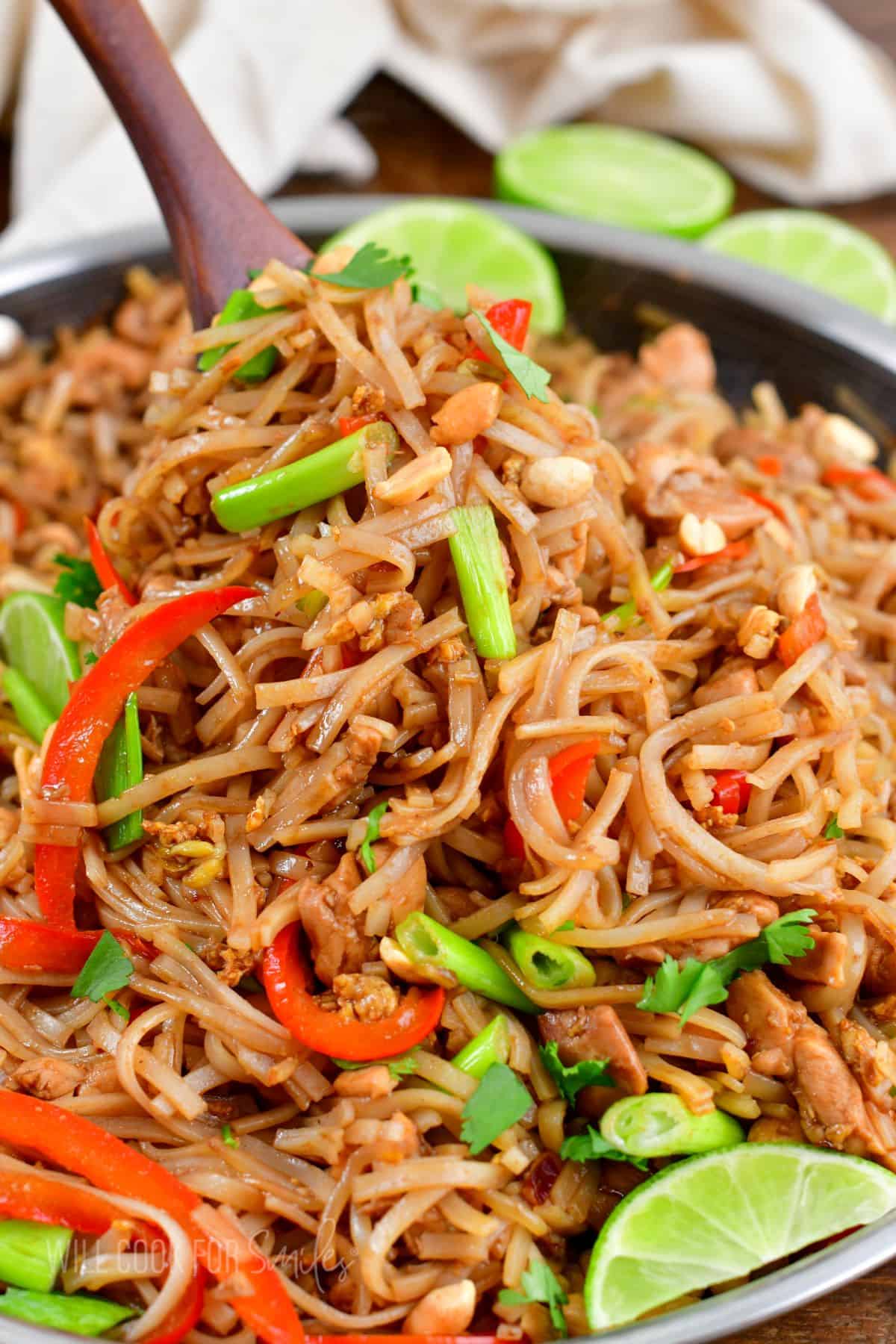
Table of Contents
What Is Pan Thai?
Pad Thai is Thailand’s national dish that’s often sold as street food. Here, in United States, it’s probably the most popular dish in Thai restaurants. It’s a Thai rice noodle stir fry with common ingredients like rice noodles, eggs, tofu (or chicken, or shrimp), garlic, bean sprouts, crushed peanuts, lime wedges, cilantro, and of course, the sauce!
Pad Thai sauce is the most important element for the vibrant flavors of this dish. When making pad Thai, you want to make sure to include Tamarind paste, fish sauce, and some sugar. This will give the sauce its signature sweet, tangy, and salty taste. Tamarind paste is the key to the good, authentic sauce – so don’t skip it.
This sauce will give your pad Thai the best bold flavors. There is a pleasant combination of textures here too that compliment all of the sweet, sour, and salty flavors. Note the crunch from crushed peanuts, light crisp from bean sprouts, soft cooked onions and peppers. Though there are a lot of ingredients, this is a truly easy dish with big flavors.
Ingredient Notes
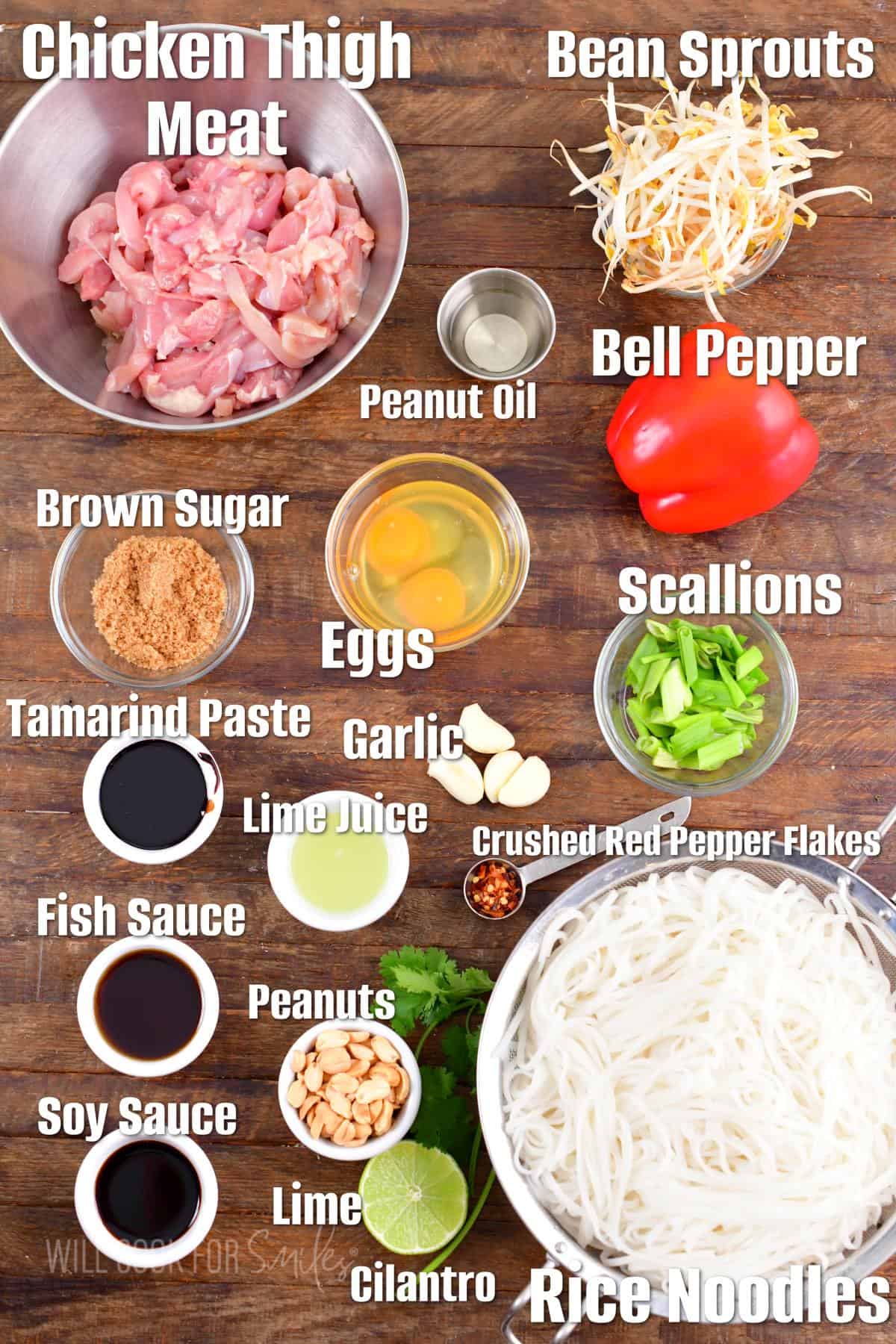
Protein – Tofu is the most traditional choice, but in the Western version, we are more used to chicken or shrimp.
Rice Noodles – Thai rice noodles are sold in almost every grocery store, so you won’t have trouble finding it.
Vegetables – Garlic, bell peppers, green onions, and bean sprouts are the vegetables you will most often find in Pad Thai. Other vegetables you can include are carrots, cabbage, broccoli, mushrooms, and even zoodles.
Red Pepper Flakes – Because you need a little spice. How much spice? You can adjust it to your own heat tolerance.
Eggs – Scramble the eggs right in the same pan, near the vegetables, so the eggs pick up those flavors.
Peanuts – It just won’t be right without including some crunchy crushed peanuts to the finished dish.
Limes – A squeeze of fresh lime juice into the cooked dish will be the perfect finish.
Cilantro – Just like the lime juice, cilantro is a great flavor compliment to the finished dish.
See the recipe card below for the full list of ingredients and instructions.
What’s in Pad Thai Sauce?
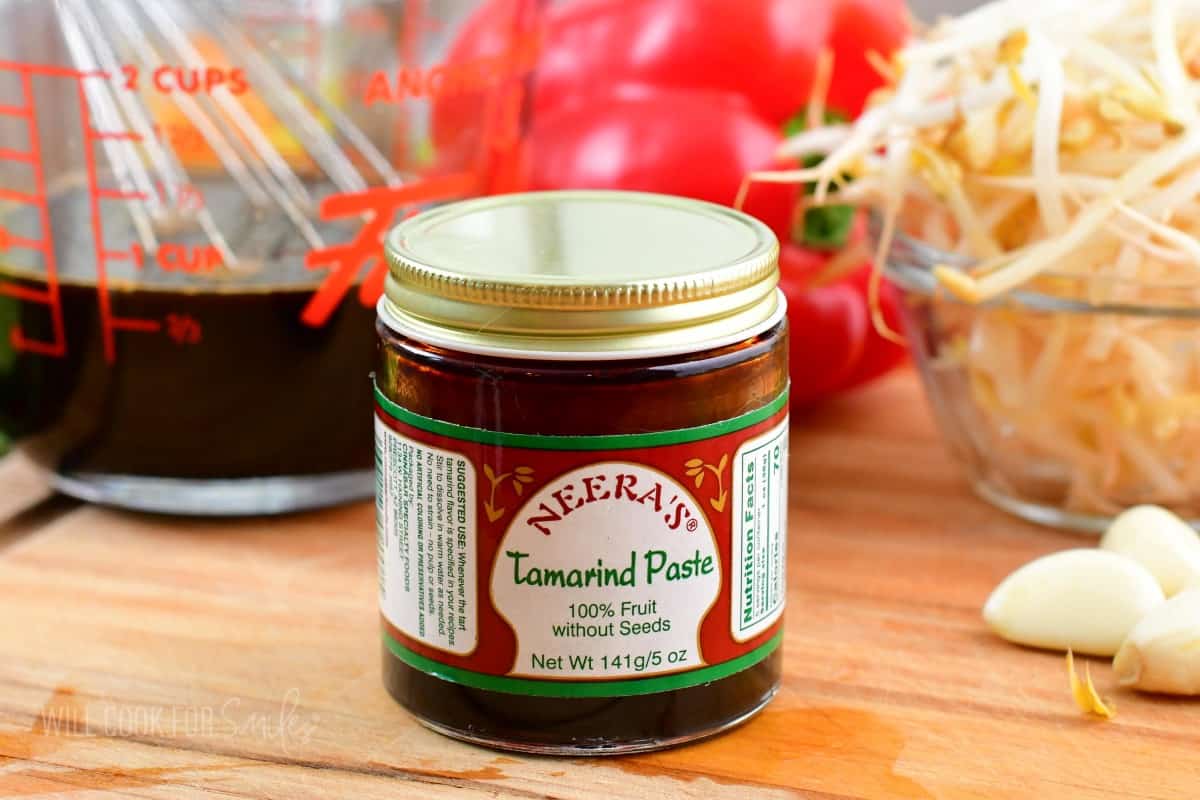
Tamarind Paste – This is the most important ingredient in this sauce, so don’t skip it. Scroll down to the FAQ section for more info!
Fish Sauce – It’s a staple sauce in many Asian recipes and another important ingredients that adds a lot of flavor to the dish. It smells quite funky but it will taste so good in the sauce!
Brown Sugar – Sugar will provide a perfect balance to the strong, salty and tangy ingredients.
Lime Juice – Squeeze fresh lemon into the sauce, it will taste much better than store-bought.
Soy Sauce – Use low sodium soy sauce so it’s not as bold and overpowering.
PRO TIP: Don’t smell the sauce! Yes, the sauce mixture will smell unappetizing because of the fish sauce but it will taste incredible in the dish, I promise!
How to Make Pad Thai
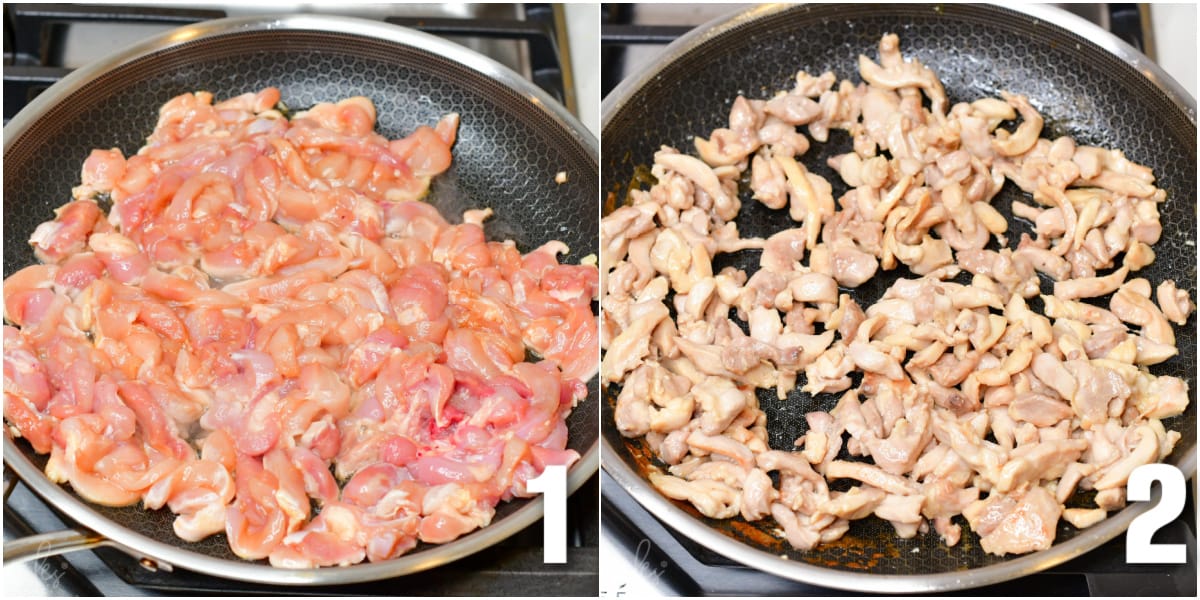
Cook the chicken. Preheat a large pan over medium-high heat. Add 2 tbsp. of peanut oil and sauté diced chicken thigh meat in the pan until just done (1,2). Take the chicken out of the pan and set aside.
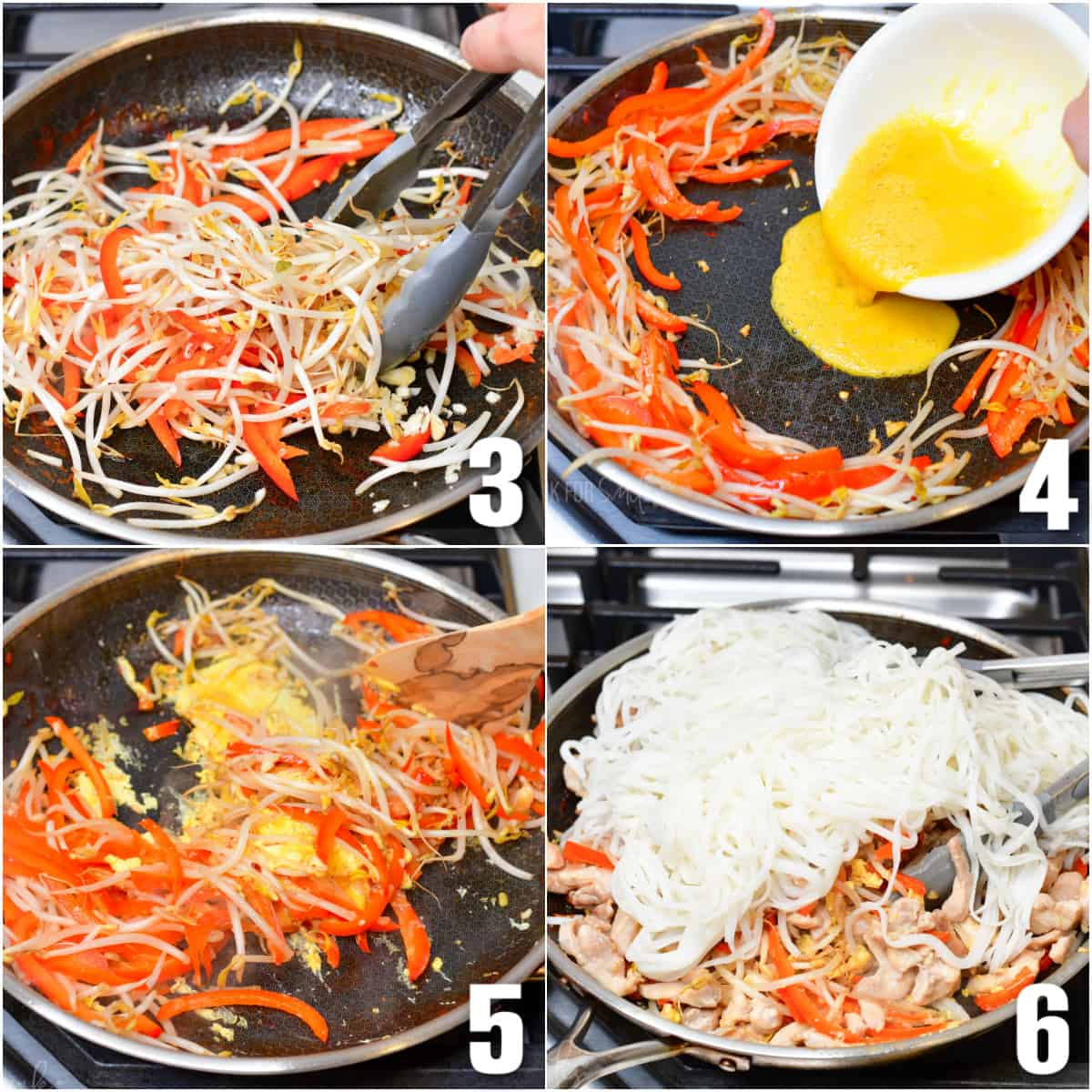
Cook the veggies. Add a little more oil to the pan and sauté bell peppers until they start to soften. Add garlic, red pepper flakes, and bean sprouts (3). Stir and sauté for just a couple of minutes and move veggies to the sides of the pan.
Add the eggs. Pour whisked eggs into the center of the pan (4). Let them cook a little and then scramble and mix with vegetables (5).
Add chicken and noodles. Add chicken back in and add cooked rice noodles to the pan (6).
Make it saucy! Pour in the sauce mixture and toss everything together to combine (7). Stir in green onions and cook for a couple more minutes (8).
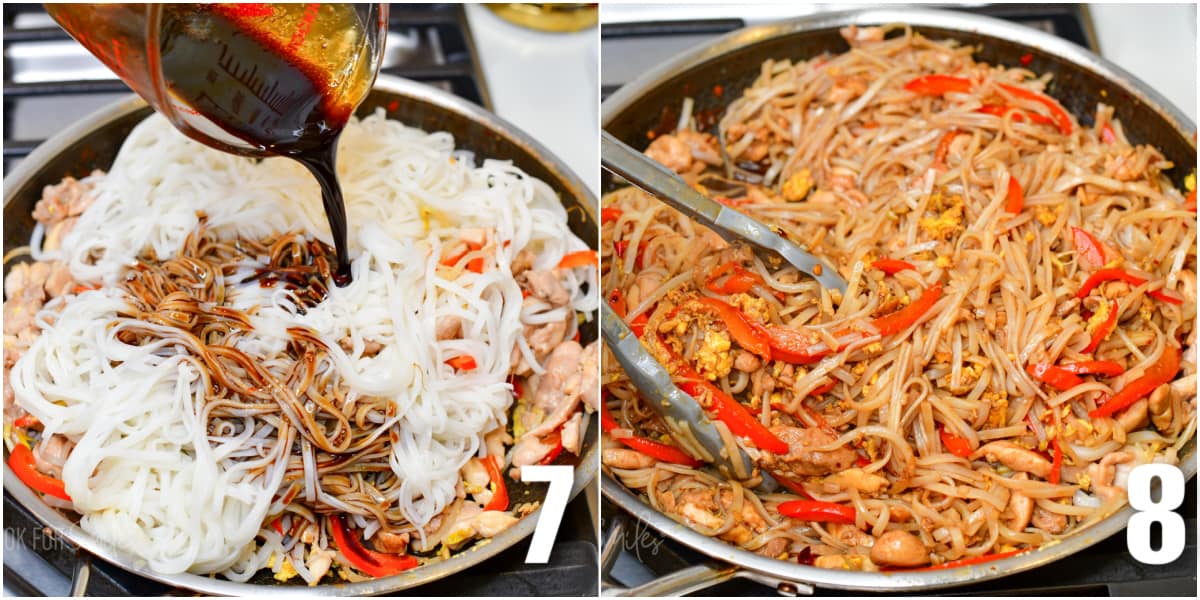
Recipe FAQs
Yes, absolutely! Sear the shrimp first over medium-high heat until opaque on one side, then flip each shrimp. Cook just until they turn opaque on the other side and set them aside just like you would chicken. Shrimp will cook much faster than chicken.
As it comes, it is not gluten-free because of the soy sauce. However, you can easily substitute the soy sauce for gluten-free soy sauce, tamari, or coconut aminos.
It’s a pulp of the tamarind fruit that is often used in Indian and Asian cuisines. It tastes sour, tangy, and a little sweet. This is the most important ingredients in this sauce, so don’t skip it. Check your local Asian market to find it and I often find mine at Whole Foods. It’s also available on Amazon. You may see options for tamarind concentrate or tamarind paste. The paste (or puree) is a little easier to use because you just scoop and add it to the sauce. Tamarind concentrate has to be mixed with hot boiling water to create the paste.
Tamarind is not salty. It balances very well with salty and sweet flavors of the sauce. I don’t recommend substituting it for more soy sauce because it is a different flavor and again, it is not salty but soy sauce is.
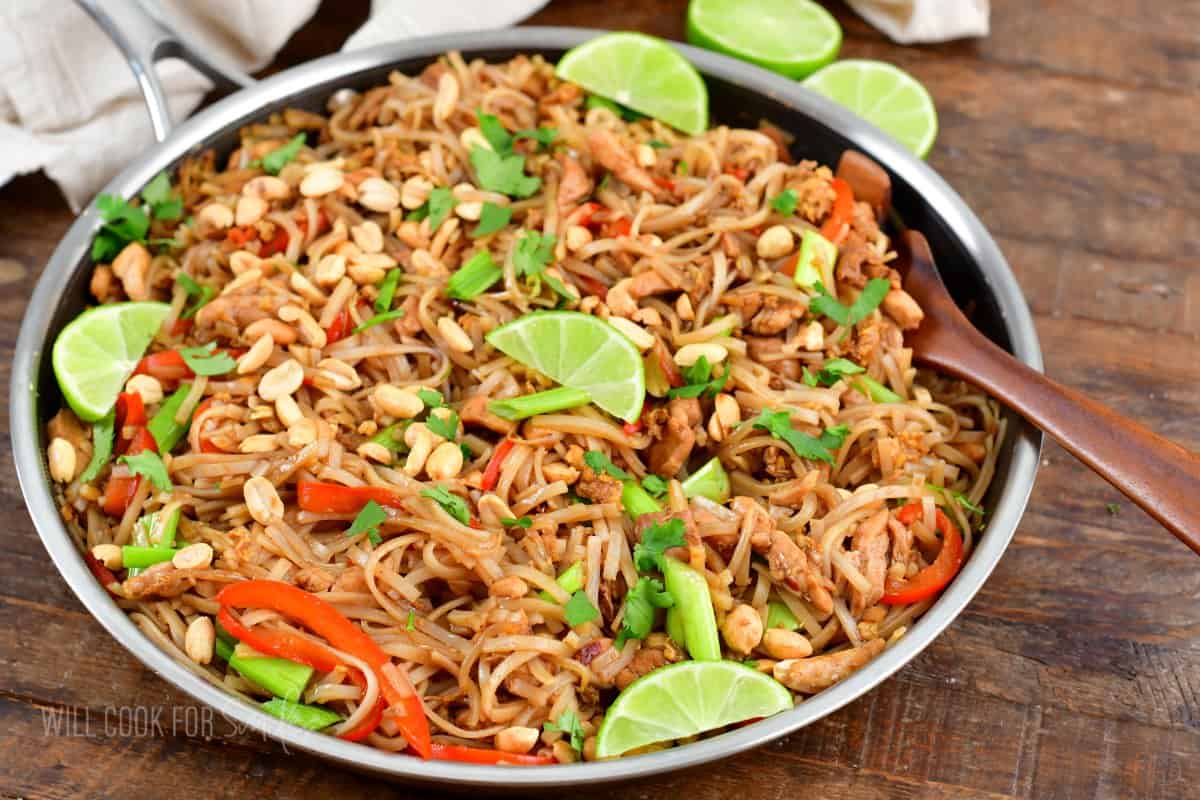
Storing and Reheating
Store any leftover pad Thai in the refrigerator in an airtight container for up to 3 days.
It’s a little tricky to reheat it because rice noodles tend to dry out a little. I found that the best way to reheat pad Thai is actually in a pan with a little chicken broth to reinvigorate the noodles. Add a little oil to the pan first, before adding cold noodles. Drizzle a couple of tablespoons of chicken broth (more if reheating a large amount), toss, and let it heat through over medium heat.
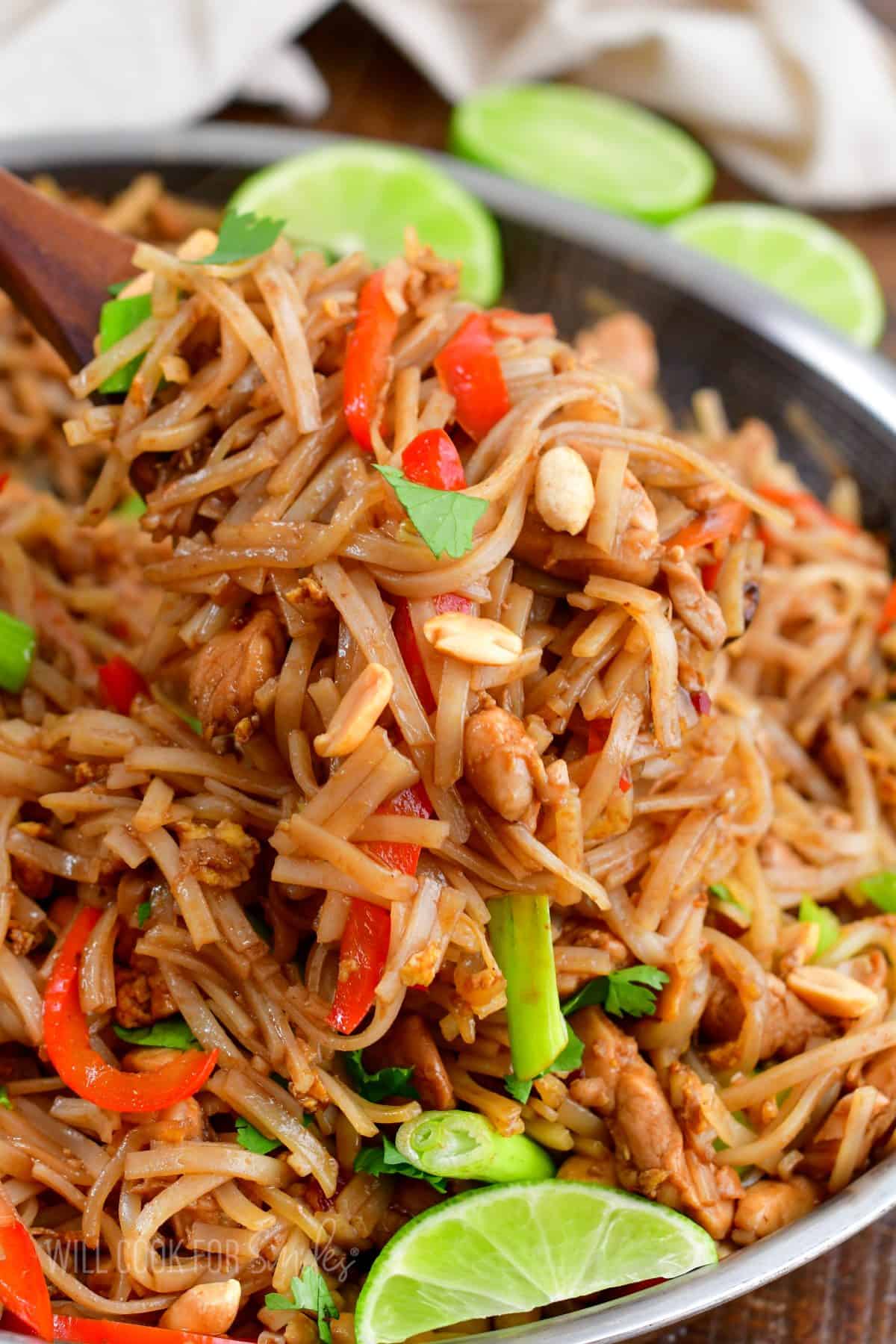
Tools For This Recipe
(Affiliate links)
Cutting Board – use plastic cutting board when working with raw meats! If working with a lot of meat, this large cutting board is great. Wooden Cutting Board
More Amazing Thai Recipes To Try
DID YOU MAKE THIS RECIPE? PLEASE leave a 🌟 star rating! Let me know how you liked it by leaving the 📝 comment below or share and tag me on social media @willcookforsmiles. DON’T FORGET to subscribe to my newsletter!

Pad Thai Recipe
Ingredients
- 14 oz rice noodles
Chicken:
- 2 tbsp peanut oil
- 1.5 lbs chicken thigh meat – boneless skinless
Vegetables:
- 2 tbsp peanut oil
- 1 large red bell pepper
- 6 oz bean sprouts
- 4 large cloves of garlic
- 1/2 tsp red pepper flakes
- 1/4 cup chopped green onion
Eggs:
- 2 eggs
Pad Thai Sauce:
- 1/4 cup tamarind paste
- 1/4 cup fish sauce
- 3 tbsp soy sauce
- 2 tbsp lime juice
- 1/4 cup brown sugar
- 1/2 tsp minced dried chili peppers – OPTIONAL more or less according to personal preference
Toppings:
- 1/2 cup crushed peanuts
- 2-3 wedges of limes – lime juice only
- 2 tbsp minced fresh cilantro
Instructions
Rice Noodles:
- Cook rice noodles according to the package instruction but under-cook them slightly. Drain off water and set aside. (While pasta is cooking prepare other ingredients.)
Before Cookies:
- Prepare all ingredients before starting to cook:Place bean sprouts in a bowl of cold water to soak. (Take bean sprout of the water and shake off excess water before adding it to the pan.) Slice bell pepper, smash and mince garlic, and dice green onions. Dice chicken and set aside. Whisk eggs in a bowl and set aside. Combine all ingredients for the sauce, whisk, and set aside.
Cooking Pad Thai:
- Preheat a large pan over medium-high heat. Add 2 tbsp. of peanut oil and saute diced chicken thigh meat in the pan until just done. Take the chicken out of the pan and set aside.
- Add a little more oil to the pan and saute bell peppers until they start to soften. Add garlic, red pepper flakes, and bean sprouts. Stir and saute for just a couple of minutes and move veggies to the sides of the pan.
- Pour whisked eggs into the center of the pan. Let them cook a little and then scramble and mix with vegetables.
- Add chicken back in and add cooked rice noodles to the pan.
- Pour in the sauce mixture and toss everything together to combine. Stir in green onions and cook for a couple more minutes.
- Sprinkle crushes peanuts, cilantro, and squeeze a couple of lime wedges over the noodles. Mix and serve!
Video
Notes
- Gluten Free Notes: As it comes, this dish not gluten-free because of the soy sauce. However, you can easily substitute the soy sauce for gluten-free soy sauce, tamari, or coconut aminos.
- Tamarind paste: It’s a pulp of the tamarind fruit that is often used in Indian and Asian cuisines. It tastes sour, tangy, and a little sweet. Tamarind is not salty. I don’t recommend substituting it for more soy sauce because it is a different flavor and again, it is not salty but soy sauce is. Check you local grocery stores and Asian stores for this ingredient. It keeps very well closed in the refrigerator.
- Reheating Notes: I found that the best way to reheat pad Thai is actually in a pan with a little chicken broth to reinvigorate the noodles. Add a little oil to the pan first, before adding cold noodles. Drizzle a couple of tablespoons of chicken broth (more if reheating a large amount), toss, and let it heat through over medium heat.
Nutrition
Originally published on Will Cook For Smiles April 17, 2013.
All images and text ©Lyubov Brooke for ©Will Cook For Smiles. Please do not use my images without prior permission. If using my posts in collections and features, please link back to this post for the recipe.
Disclaimer: Nutrition information shown is not guaranteed to be 100% accurate as most ingredients and brands have variations.
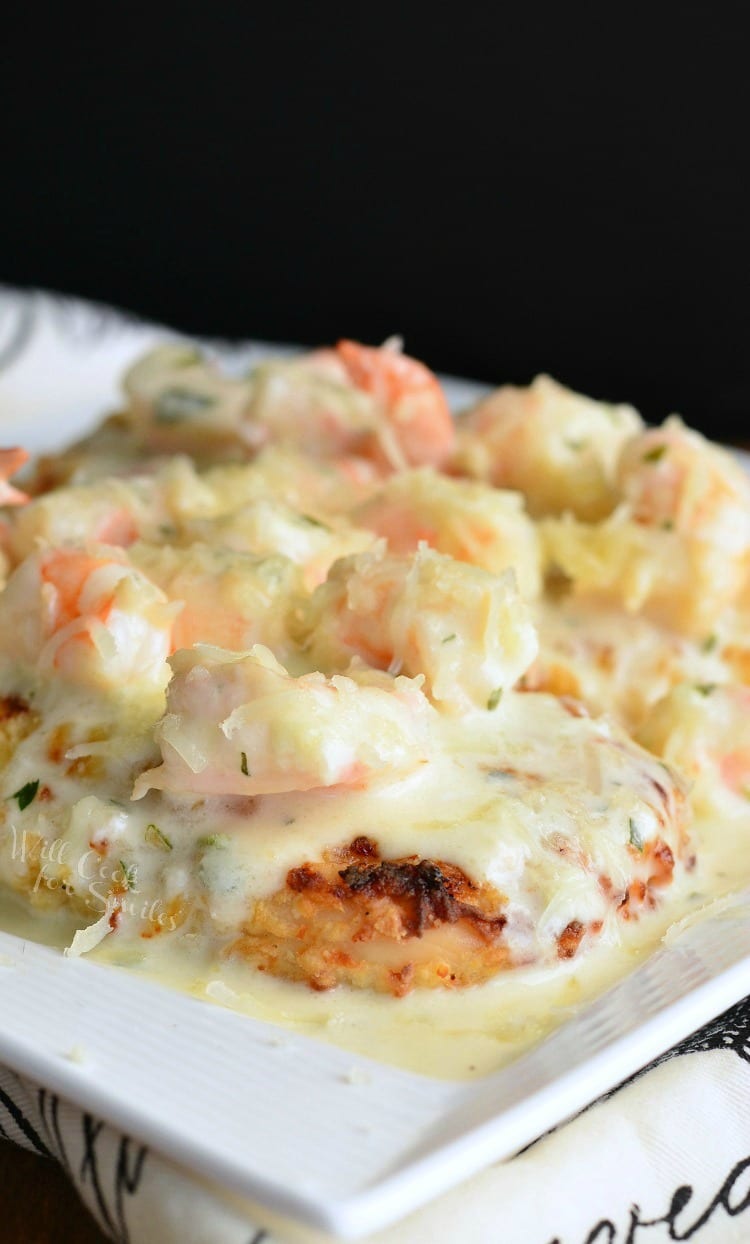
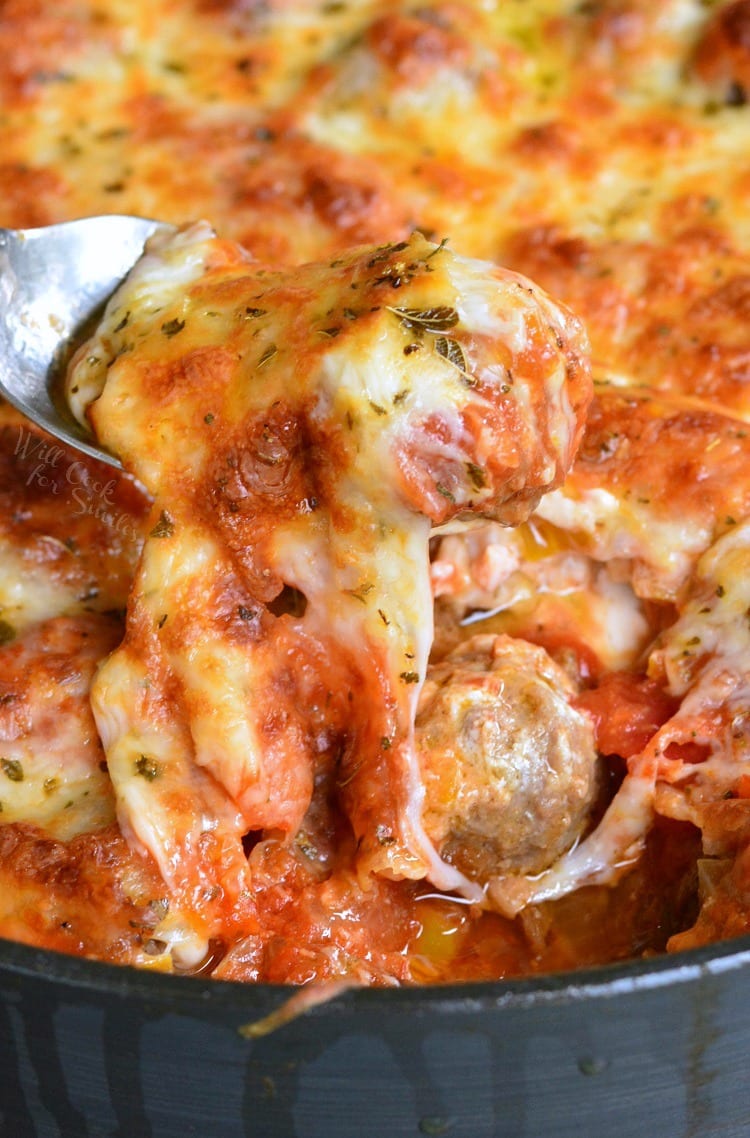
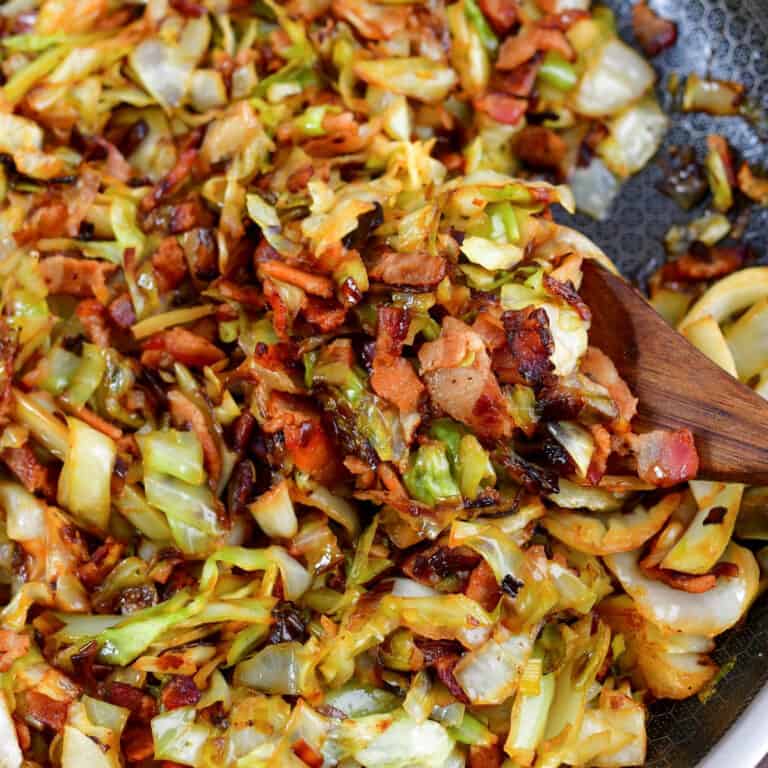
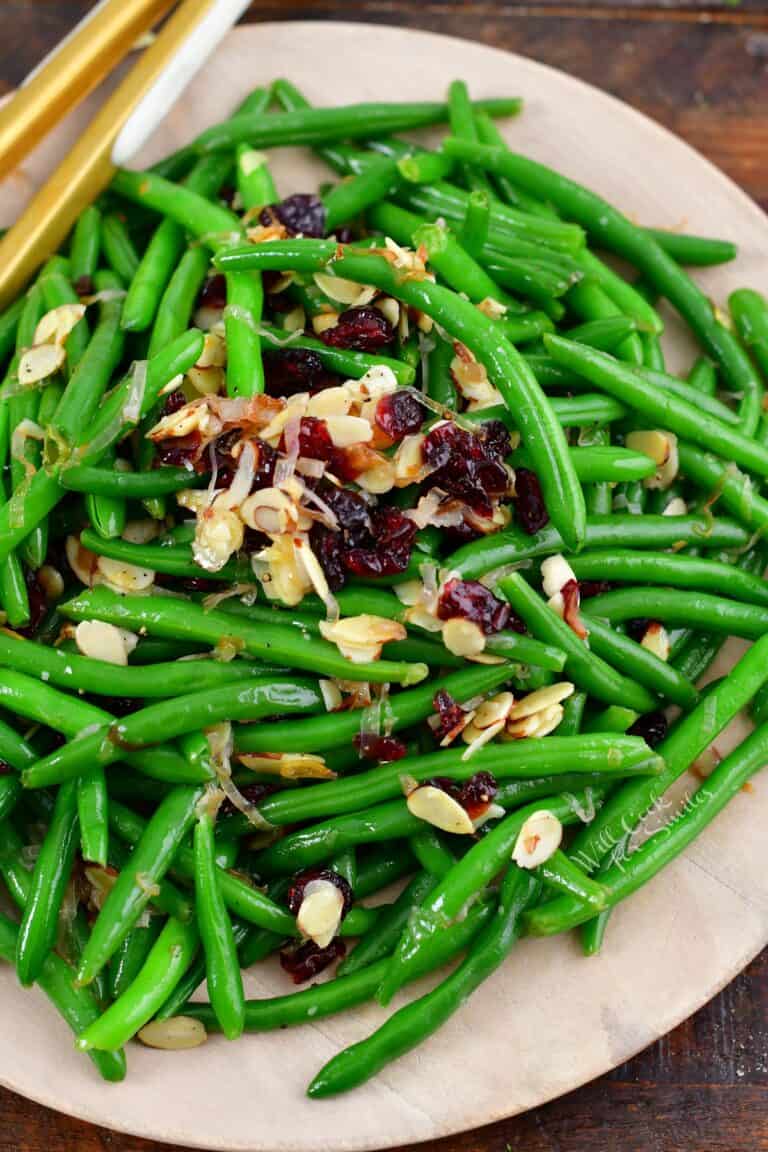
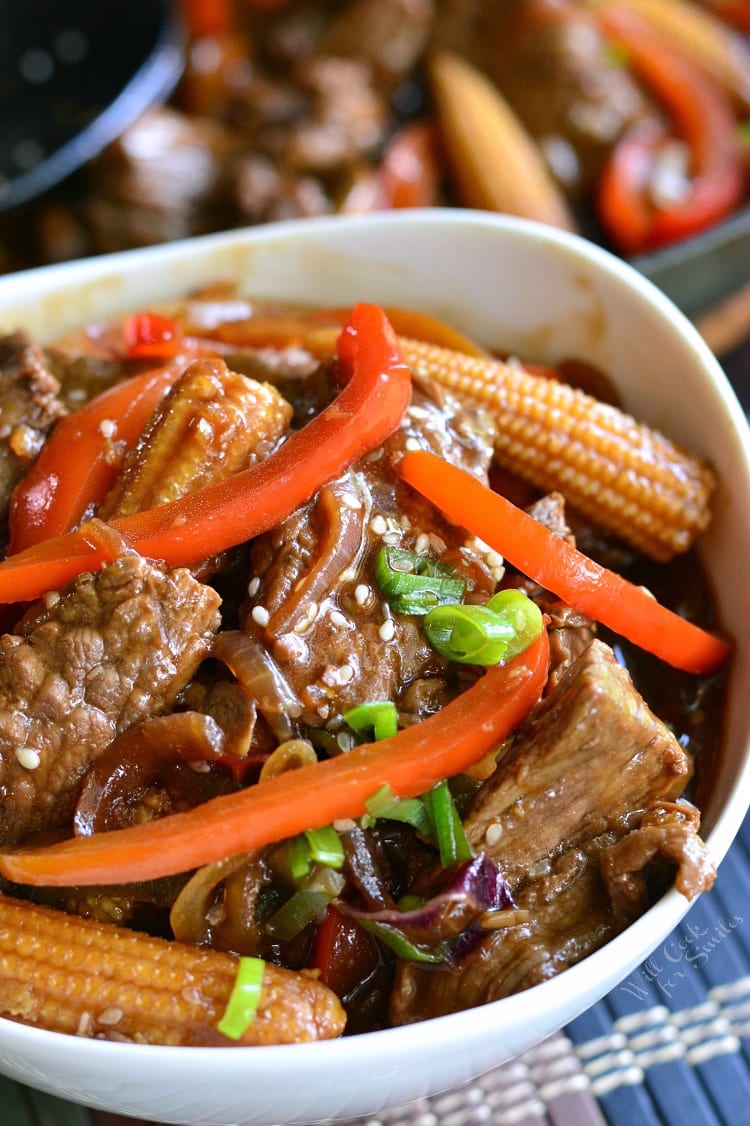
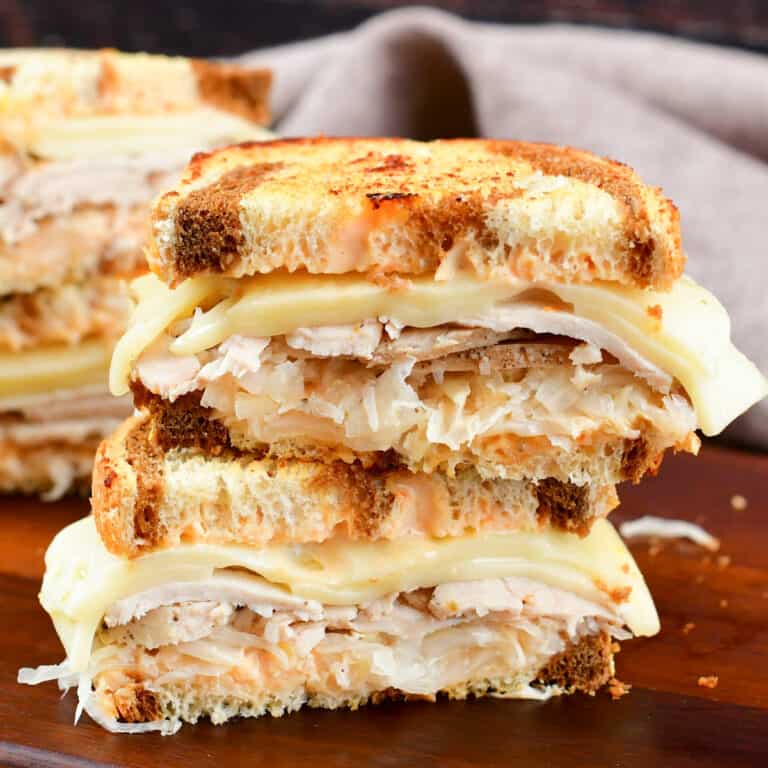








Eggs are not on the ingredients list. Had to scroll through the photos to find the eggs in a bowl. I used 2
Have tried many pad Thai recipes online and none compare! Making this for a second time this week! Great reviews from my family as well. Will be a new go-to!!
I am so glad you liked it, Jade!
I only have canned bean sprouts. Are they okay to use?
I absolutely loved the flavor in this pad Thai, totally on point! It has that “something” that I generally find lacking when I recreate a favorite dish at home. Fabulous!!
I am so glad you liked it so much!
I didn’t have any tamarind paste, but read that you could substitute it with equal parts rice vinegar and brown sugar. After reading reviews and hearing it was too sour, I added 2 spoonfuls of peanut butter, another 1/4 cup of brown sugar and a squirt of ketchup. Everything turned out exactly how pad Thai should taste like! Also added onions and snap peas.
I am glad you liked it.
How do I get the sauce to be sweeter and more peanut flavor? I want it to taste like it does at a restaurant. I didn’t put Tamarid sauce in. What flavor will that give it?
There isn’t supposed to be a big peanut flavor in pad thai besides the peanuts but you could add extra if you like the taste. You can also add another tablespoon of brown sugar if you want it to be sweeter. Tamatri paste is kinda like a bolder thicker soy sauce that is less salty, so it gives it a big flavor without being overly salty.
Great recipe! I think next time I will leave the lime juice out of the sauce and just add lime wedges for lime flavor so each individual can add amount to their liking. Thanks for sharing.
Glad you liked it, Cindy!
Can I leave the fish sauce out ? Or can I use some other substitute?
You could substitute it for oyster sauce or soy sauce.
Loved this recipe! Added snow peas for a nice crunch. Noodles were perfect. I would like a little more tamarind flavor. However, the noodles veggies chicken on the bottom of my wok were amazing! I did use a very small amount of sesame oil when cooking the veggies, chicken etc. Thanks for sharing! This recipe is a keeper for me!
So glad you liked it, Cindy!
Can you substitute peanut oil with Sesame oil? Looks like a great recipe.
If you use more than a dash of semese oil it will overpower everything else in the dish so to substitute it use a mild oil like canola, avocado, or vegetable oil.
Not good….did not taste like pad thai. Something in it maybe the fish was way too strong and overpowered the whole dish. Couldn’t even have more than a few bites 🙁 would NOT recommend
The flavor is good. What do you do to keep the noodles from clumping? I made them per the instructions that came with them but several stuck together which made noodles a bit rough. Thanks!
Hi Lynn,
Next time I would make sure water was at a complete boil dump in the pasta and be sure to stir it. Also, pasta should be stirred often while cooking—especially in the first few minutes of cooking to insure they do not stick.
Clearly you don’t know what pad thai is supposed to taste like then..